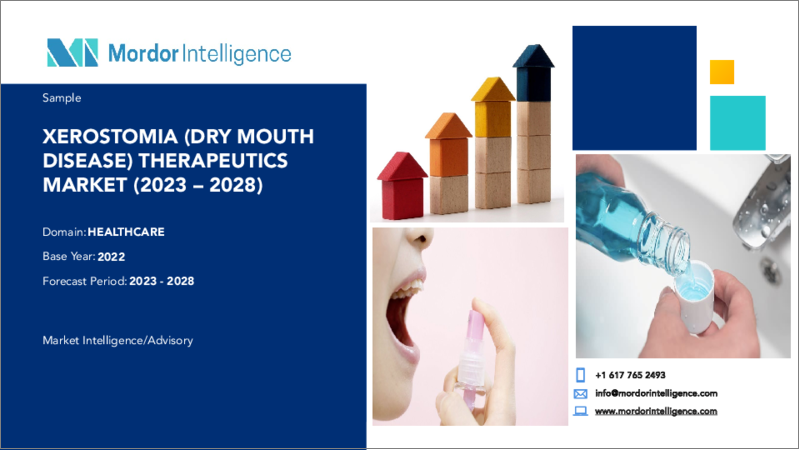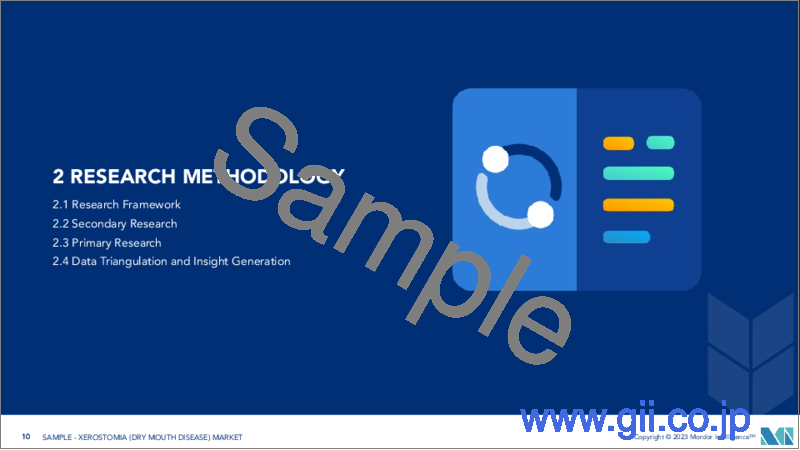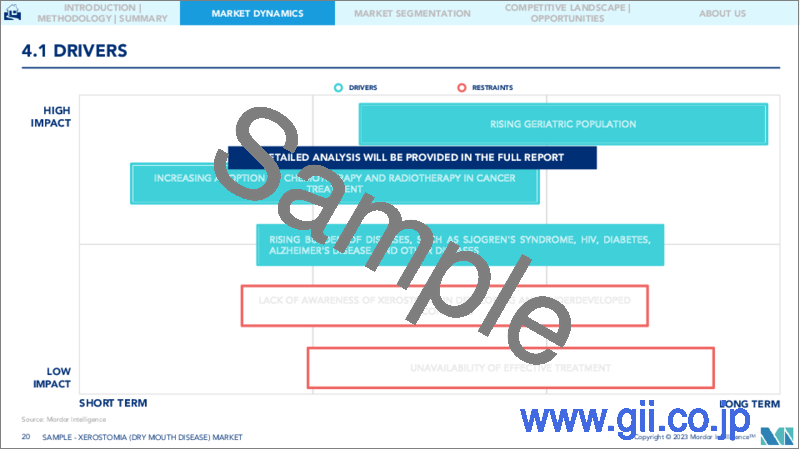|
|
市場調査レポート
商品コード
1198844
口腔乾燥症(ドライマウス疾患)治療薬市場- 成長、動向、予測(2023年-2028年)Xerostomia (Dry Mouth Disease) Therapeutics Market - Growth, Trends, and Forecasts (2023 - 2028) |
||||||
|
● お客様のご希望に応じて、既存データの加工や未掲載情報(例:国別セグメント)の追加などの対応が可能です。 詳細はお問い合わせください。 |
|||||||
| 口腔乾燥症(ドライマウス疾患)治療薬市場- 成長、動向、予測(2023年-2028年) |
|
出版日: 2023年01月23日
発行: Mordor Intelligence
ページ情報: 英文 117 Pages
納期: 2~3営業日
|
- 全表示
- 概要
- 目次
口腔乾燥症(ドライマウス疾患)治療薬市場は、予測期間(2022-2027年)にCAGR4.25%を記録すると予測されています。
COVID-19の大流行は、口腔衛生を含む個人の生活のあらゆる面で新たな課題を提起しています。ドライマウスは、あらゆる階層の患者が抱える最も一般的な問題の1つになっています。COVID-19は、症状としてドライマウスとの関連も指摘されています。2021年4月に発表された「Xerostomia(dry mouth)in patients with COVID-19:a case series」という論文によると、ドライマウスは前駆症状として3~4日前に現れるケースが6割、その他は他の症状の発症と同時または1~2日後に現れるとのことです。大多数の症例で、ドライマウスは治療開始後、時間の経過とともに改善しました。さらに、COVID-19の患者さんでは、一般的な症状の発症前に口腔乾燥が生じる場合があると述べています。このような研究は、COVID-19患者における症状の頻度を示し、それゆえ、ドライマウス疾患の治療薬に対する需要が近い将来に成長すると予想されることを示唆しています。したがって、COVID-19は市場の成長に顕著な影響を及ぼすと予想されます。
口腔乾燥症は、一般的に「ドライマウス症候群」と呼ばれ、唾液の流出が減少または消失することにより、粘膜の乾燥を生じます。放射線療法や化学療法の増加は口腔乾燥症の発生率の増加につながると考えられ、これが口腔乾燥症治療薬市場を主に牽引すると推定されます。市場成長のその他の要因としては、処方薬の使用量の増加、医薬品の容易な入手と費用対効果、老人人口の増加、シェーグレン症候群、HIV、糖尿病、アルツハイマー病などの疾患の有病率の増加などが挙げられます。
さらに、老年人口が調査対象市場に大きな影響を及ぼすと予想されます。例えば、World Population Prospect, 2022によると、世界全体で、2022年には65歳以上の人口は7億7100万人であり、2030年には9億9400万人、2050年には16億人に達すると予測されています。高齢者では、唾液腺活動の低下を代表とする口腔乾燥が頻繁に起こります。高齢者における口腔乾燥の原因としては、薬剤の使用、慢性疾患、頭頸部への放射線療法などが挙げられています。
さらに、国際糖尿病連合によると、2021年現在、世界には20~79歳の5億3660万人が糖尿病を患っており、2045年にはこの数が7億8370万人に達すると予想されています。糖尿病は、しばしばドライマウス症候群を伴います。例えば、「Xerostomia, Salivary Flow, and Oral Health Status Among Saudi Diabetic Patients」というタイトルの論文によると、サウジアラビアの糖尿病患者における口腔内の健康状態を調査しています。2021年11月にNational Library of Medicineに掲載された「A Comparative Cross-Sectional Study」では、糖尿病の症状の中で最も多く報告されたのがXerostomia(口腔乾燥症)でした。糖尿病患者において、口腔乾燥は12.5%から76.4%の確率で発生するとされています。さらに、サウジアラビアの糖尿病患者50人を対象にした横断的調査のデータを詳細に見ると、対照群の52%、糖尿病患者の60%がともに口腔乾燥症を呈していたとのことです。このように、口腔乾燥につながる疾患の負担増は、市場の成長を促進すると予想されます。
このように、市場は時間の経過とともに大きな成長を遂げると予想されます。しかし、認知度の低さや効果的な治療法が確立されていないなどの要因が口腔乾燥症治療薬の使用を妨げ、口腔乾燥症治療薬市場の抑制要因として働く可能性があります。
口腔乾燥症(ドライマウス疾患)治療薬市場動向
人工唾液/唾液代替物セグメントが予測期間中に市場を独占すると予想される
口腔内の唾液が減少すると、虫歯、口内炎、味覚や嗅覚の変化、嚥下困難、痛み、その他多くの合併症を引き起こす可能性があります。人工唾液は、口の中に噴霧される液体またはエアゾール製品です。これらは、特に定期的に使用することで、慢性的なドライマウスの痛みと不快感を和らげ、潤いを与えるように設計されています。多くの人工唾液スプレーやジェルは、最大2時間の効果を謳っており、多くのユーザーは、口腔内の水分を維持するために、より頻繁な塗布を必要とし、睡眠や日常の活動に大きな支障をきたすことがあります。また、いくつかの唾液スプレーやジェルには、強くて不快な風味があるという評判がありますが、最近では自然な甘さのキシリトールの使用が増え、より良い代替品が利用できるようになっています。
ドライマウス疾患の負担の増加や調査研究の増加などの要因が、この市場セグメントの成長を促進しています。例えば、「糖尿病性口腔乾燥症における人工唾液(ASDIX)」と題された記事です。2020年7月に発表された「Aldiamed Versus Placeboの二重盲検試験」では、1型および2型糖尿病における口腔乾燥症の治療において、Aldiamedスプレーの使用はプラセボよりも有効であることが示されたと結論付けています。このような研究は、唾液代替物が口腔乾燥症の治療に有効であることを実証しています。また、同出典は、ドライマウス症状は、糖尿病患者における最も一般的な口腔内愁訴の1つであると報告しています。さらに、口腔乾燥と唾液分泌低下の有病率は、年齢とともに増加することが報告されています。また、近い将来、糖尿病や高齢者の負担が急増することが予想されるため、今後数年間は唾液代替物の需要が増加する可能性があると本調査では予測しています。
したがって、前述の要因に加え、疾病負担の増加や市販の人工唾液製品の利用可能性により、この分野は予測期間中に安定した成長を記録すると予想されます。
予測期間中、アジア太平洋地域が最も急速に成長すると予想される
アジア太平洋地域は、医療費の増加、意識向上への取り組みの増加、ドライマウス状態を引き起こす糖尿病、HIV、がん、パーキンソン病などの疾患の有病率の上昇などの要因から、予測期間中に有利な成長を記録すると予想されます。
アジア太平洋地域では、がん罹患率が急激に増加しています。例えば、GLOBOCAN 2020によると、アジアにおける新たながん患者数は9,386,454人であり、2040年には14,229,878人に達すると予測されています。中国やインドなどの新興国は、医療政策と産業政策の両面から抗がん剤の国産化を推進しており、治療費の低減につながっています。治療費の低減は、がんに対する意識の高まりと相まって、化学療法や放射線療法の普及につながっています。がんの負担の増大は、放射線療法や化学療法をより多く採用することにつながり、さらに治療に伴うドライマウスの状態にもつながっています。したがって、口腔乾燥症を治療するための治療薬のニーズが生まれ、最終的にこの地域の市場成長を後押ししています。
また、2021年11月に発表された「An Update on the Lived Experience of Dry Mouth in Sjogren's Syndrome Patients」と題する記事の通り、ドライマウスはシェーグレン症候群(SS)の人々の日常生活に影響を与える重要な症状です。同出典によると、シェーグレン国際共同臨床同盟(SICCA)登録のSS患者1578名において、90%がドライマウスの症状を訴えたとされています。さらに、2021年9月に発表された「Analysis of medication-induced xerostomia in elderly Japanese patients」という論文では、高齢者が摂取する薬剤の数が増える傾向にあるため、口腔乾燥症のリスクも年齢とともに増加すると述べています。したがって、慢性疾患の有病率の増加により、薬剤の使用量が増加し、それによってドライマウスが引き起こされるのです。
このような要因が、アジア太平洋地域における市場の成長を後押ししていると考えられます。
口腔乾燥症(ドライマウス疾患)治療薬市場の競合企業分析
口腔乾燥症治療薬市場の競争は緩やかです。口腔乾燥症(ドライマウス疾患)治療薬市場の主なプレイヤーは、地理的プレゼンスを高めるために、製品ポートフォリオの開発、新興プレイヤーの買収、販売協定に注力しています。口腔乾燥症治療薬市場を独占している主要企業には、3M、GlaxoSmithKline PLC、Hikma Pharmaceuticals PLC、Lupin、Parnell Pharmaceuticals Inc、Sun Pharmaceutical Industries Ltd.、Synedgenなどが挙げられます。
その他の特典
- エクセル形式の市場予測(ME)シート
- 3ヶ月間のアナリストサポート
目次
第1章 イントロダクション
- 調査の前提条件と市場の定義
- 調査対象範囲
第2章 調査手法
第3章 エグゼクティブサマリー
第4章 市場力学
- 市場概要
- 市場促進要因
- 老年人口の増加
- がん治療における化学療法と放射線療法の普及の増加
- シェーグレン症候群、HIV、糖尿病、アルツハイマー病、その他の疾病の負担増
- 市場抑制要因
- 新興経済諸国における口腔乾燥症の認知度の低さ
- 効果的な治療法の欠如
- ポーターのファイブフォース分析
- 新規参入業者の脅威
- 買い手/消費者の交渉力
- 供給企業の交渉力
- 代替品の脅威
- 競争企業間の敵対関係
第5章 市場セグメンテーション(金額ベース市場規模:百万米ドル)
- タイプ別
- 人工唾液/唾液代替品
- 唾液分泌促進剤
- 製品別
- 医薬品
- 唾液腺ペン
- その他製品タイプ
- 販売チャネル別
- 病院薬局
- 小売店
- オンライン薬局
- 地域別
- 北米
- 米国
- カナダ
- メキシコ
- 欧州
- ドイツ
- 英国
- フランス
- イタリア
- スペイン
- その他の欧州地域
- アジア太平洋地域
- 中国
- 日本
- インド
- オーストラリア
- 韓国
- その他アジア太平洋地域
- 中東地域
- GCC
- 南アフリカ
- その他の中東地域
- 南米
- ブラジル
- アルゼンチン
- その他の南米地域
- 北米
第6章 競合情勢
- 企業プロファイル
- Quest Products Inc.
- Fresenius SE & Co. KGaA
- GlaxoSmithKline PLC
- Hikma Pharmaceuticals PLC
- Lupin Limited
- Pharmascience Inc(Pendopharm)
- Parnell Pharmaceuticals Inc.
- Sun Pharmaceutical Industries Ltd
- Synedgen Inc.(Prisyna)
- ADVANZ PHARMA Corp. Limited
- Saliwell Ltd
- 3M company
- Sanofi(Chattem, Inc.)
第7章 市場機会と今後の動向
The Xerostomia (Dry Mouth Disease) Therapeutics market is projected to register a CAGR of 4.25% during the forecast period (2022-2027).
The COVID-19 pandemic has posed new challenges in every aspect of an individual's life, including oral health. Dry mouth has become one of the most common problems that patients from all walks of life are dealing with. COVID-19 has also been linked to dry mouth as a symptom. According to the article titled "Xerostomia (dry mouth) in patients with COVID-19: a case series" published in April 2021, dry mouth appeared in 60% of cases 3-4 days before as a prodromal symptom and in others, simultaneously or 1-2 days after the onset of other symptoms. In the majority of cases, dry mouth improved over time after beginning treatment. The study further stated that in COVID-19 patients, xerostomia may develop before the onset of the common symptoms. Such studies demonstrate the frequency of the condition in COVID-19 patients and hence suggest that the demand for therapeutics for dry mouth disease is anticipated to grow in the near future. Thus, COVID-19 is expected to have a pronounced effect on the growth of the market.
Xerostomia commonly referred to as "dry mouth syndrome", is a result of reduced or absent salivary flow, producing mucosal dryness. The increase in radiation therapy and chemotherapy is likely to lead to an increased incidence of xerostomia, which is estimated to predominantly drive the xerostomia therapeutics market. Other factors driving the market growth include increasing usage of prescription medicines; easy availability and cost-effectiveness of medicines; a growing geriatric population base; and increasing prevalence of diseases, such as Sjogren's syndrome, HIV, diabetes, and Alzheimer's disease, among other diseases.
Additionally, the geriatric population is expected to have a significant impact on the market studied. For instance, according to the World Population Prospect, 2022, globally, in 2022, there were 771 million people aged 65 years or over, and it is projected to reach 994 million by 2030 and 1.6 billion by 2050. Elderly people frequently experience xerostomia, which is typically associated with reduced salivary gland activity. The use of drugs, chronic illnesses, and radiation therapy to the head and neck region have all been implicated as causes of xerostomia in the elderly population.
Furthermore, according to the International Diabetes Federation, as of 2021, there are 536.6 million people aged 20 -79 years around the world living with diabetes, and this number is expected to reach 783.7 million by 2045. Diabetes is often associated with dry mouth syndrome. For instance, as per the article titled "Xerostomia, Salivary Flow, and Oral Health Status Among Saudi Diabetic Patients: A Comparative Cross-Sectional Study" published in the National Library of Medicine in November 2021, Xerostomia was one of the symptoms of diabetes that was most frequently reported. In diabetic patients, xerostomia can occur anywhere between 12.5% and 76.4% of the time. Further, the study detailed that the data from the cross-sectional investigation of 50 diabetic patients in Saudi Arabia was collected, wherein 52% of controls and 60% of the diabetic participants both exhibited xerostomia. Thus, the growing burden of diseases leading to xerostomia is expected to drive the growth of the market.
Thus, the market is expected to experience significant growth over time. However, factors, such as lack of awareness and unavailability of effective treatment, are likely to hinder the usage of xerostomia therapeutics products and can act as a restraining factor for the xerostomia therapeutics market.
Xerostomia (Dry Mouth Disease) Therapeutics Market Trends
Artificial Saliva/Saliva Substitutes Segment Expected to Dominate the Market Over the Forecast Period
The reduction of saliva in the mouth can lead to tooth decay, mouth infections, an altered sense of taste or smell, difficulty in swallowing, pain, and many other complications. Artificial saliva is a liquid or aerosol product that is sprayed into the mouth. They are designed to moisten and relieve the pain and discomfort of chronic dry mouth, especially with regular use. Many artificial saliva sprays and gels claim to work for up to two hours, and many users require more frequent applications to maintain moisture in the mouth, which can greatly interfere with sleep and daily activity. Several saliva sprays and gels also have a reputation for strong and unpleasant flavors, though a recent increase in the use of naturally sweet xylitol has led to the availability of better alternatives.
Factors such as the growing burden of dry mouth disease and increasing research studies are propelling the growth of the market segment. For instance, the article titled "Artificial Saliva in Diabetic Xerostomia (ASDIX): Double Blind Trial of Aldiamed Versus Placebo" published in July 2020, concluded that the use of Aldiamed spray was shown to be more effective than a placebo in the treatment of xerostomia in type 1 and type 2 diabetes. Such studies demonstrate that saliva substitutes are effective for the treatment of xerostomia. The mentioned source also reported that the dry mouth symptom is one of the most common oral complaints in patients with diabetes mellitus. Moreover, the prevalence of xerostomia and hyposalivation has been reported to increase with age. The study also projects that there may be increasing demand for saliva substitutes in the coming years as the burden of diabetes mellitus and the geriatric population is expected to show rapid growth in the near future.
Hence, owing to the aforementioned factors, along with the rising disease burden and availability of over-the-counter artificial saliva products, the segment is expected to register steady growth during the forecast period.
Asia-Pacific is Expected to be the Fastest Growing Region Over the Forecast Period
The Asia-Pacific region is expected to register lucrative growth over the forecast period due to factors such as growing healthcare expenditure, an increase in initiatives for raising awareness, and the rising prevalence of diseases such as diabetes, HIV, cancer, and Parkinson's disease that cause dry mouth conditions.
Cancer rates are increasing drastically in the Asia-Pacific region. For instance, according to GLOBOCAN 2020, there are 9,386,454 new cases of cancer in Asia, and it is projected to reach 14,229,878 by 2040. Emerging economies, such as China and India, have adopted both health and industrial policies to encourage the domestic production of cancer drugs, which is leading to lower therapy costs. Lower therapy costs, coupled with increasing awareness about cancer, are leading to higher adoption of chemotherapy and radiotherapy. The increasing burden of cancer leads to greater adoption of radiotherapy and chemotherapy, along with the dry mouth conditions associated with the treatments. Thus, this creates the need for therapeutics for treating xerostomia, which ultimately boosts the market growth in the region.
Also, as per the article titled "An Update on the Lived Experience of Dry Mouth in Sjogren's Syndrome Patients" published in November 2021, dry mouth is a significant condition that impacts the daily lives of people with Sjogren's Syndrome (SS). As per the same source, in the Sjogren's International Collaborative Clinical Alliance (SICCA) registry of 1578 SS participants, 90% reported symptoms of dry mouth. Furthermore, the article titled "Analysis of medication-induced xerostomia in elderly Japanese patients", published in September 2021, stated that the risk of xerostomia also increases with age as the number of medications the elderly population consumes tends to increase. Hence, the increasing prevalence of chronic diseases results in the increased use of medications, thereby resulting in dry mouth.
Thus, the aforesaid factors are likely to boost the growth of the market in the Asia-Pacific region.
Xerostomia (Dry Mouth Disease) Therapeutics Market Competitor Analysis
The xerostomia therapeutics market is moderately competitive. Key players in the xerostomia (dry mouth disease) therapeutics market are focusing on the development of their product portfolio, acquisition of emerging players, and distribution agreements to increase their geographical presence. Some of the key players dominating the xerostomia therapeutics market are 3M, GlaxoSmithKline PLC, Hikma Pharmaceuticals PLC, Lupin, Parnell Pharmaceuticals Inc., Sun Pharmaceutical Industries Ltd., and Synedgen, among others.
Additional Benefits:
- The market estimate (ME) sheet in Excel format
- 3 months of analyst support
TABLE OF CONTENTS
1 INTRODUCTION
- 1.1 Study Assumptions and Market Definition
- 1.2 Scope of the Study
2 RESEARCH METHODOLOGY
3 EXECUTIVE SUMMARY
4 MARKET DYNAMICS
- 4.1 Market Overview
- 4.2 Market Drivers
- 4.2.1 Rising Geriatric Population
- 4.2.2 Increasing Adoption of Chemotherapy and Radiotherapy in Cancer Treatment
- 4.2.3 Rising Burden of Diseases, such as Sjogren's Syndrome, HIV, Diabetes, Alzheimer's disease, and Other Diseases
- 4.3 Market Restraints
- 4.3.1 Lack of Awareness of Xerostomia in Developing and Underdeveloped Economies
- 4.3.2 Unavailability of Effective Treatment
- 4.4 Porter's Five Forces Analysis
- 4.4.1 Threat of New Entrants
- 4.4.2 Bargaining Power of Buyers/Consumers
- 4.4.3 Bargaining Power of Suppliers
- 4.4.4 Threat of Substitute Products
- 4.4.5 Intensity of Competitive Rivalry
5 MARKET SEGMENTATION (Market Size by Value - USD million)
- 5.1 By Type
- 5.1.1 Artificial Saliva/Saliva Substitutes
- 5.1.2 Salivary Stimulants
- 5.2 By Product
- 5.2.1 Drugs
- 5.2.2 Salivary Pens
- 5.2.3 Other Product Types
- 5.3 By Distribution Channel
- 5.3.1 Hospital Pharmacy
- 5.3.2 Retail Pharmacy
- 5.3.3 Online Pharmacy
- 5.4 Geography
- 5.4.1 North America
- 5.4.1.1 United States
- 5.4.1.2 Canada
- 5.4.1.3 Mexico
- 5.4.2 Europe
- 5.4.2.1 Germany
- 5.4.2.2 United Kingdom
- 5.4.2.3 France
- 5.4.2.4 Italy
- 5.4.2.5 Spain
- 5.4.2.6 Rest of Europe
- 5.4.3 Asia-Pacific
- 5.4.3.1 China
- 5.4.3.2 Japan
- 5.4.3.3 India
- 5.4.3.4 Australia
- 5.4.3.5 South Korea
- 5.4.3.6 Rest of Asia-Pacific
- 5.4.4 Middle East
- 5.4.4.1 GCC
- 5.4.4.2 South Africa
- 5.4.4.3 Rest of Middle East
- 5.4.5 South America
- 5.4.5.1 Brazil
- 5.4.5.2 Argentina
- 5.4.5.3 Rest of South America
- 5.4.1 North America
6 COMPETITIVE LANDSCAPE
- 6.1 Company Profiles
- 6.1.1 Quest Products Inc.
- 6.1.2 Fresenius SE & Co. KGaA
- 6.1.3 GlaxoSmithKline PLC
- 6.1.4 Hikma Pharmaceuticals PLC
- 6.1.5 Lupin Limited
- 6.1.6 Pharmascience Inc (Pendopharm)
- 6.1.7 Parnell Pharmaceuticals Inc.
- 6.1.8 Sun Pharmaceutical Industries Ltd
- 6.1.9 Synedgen Inc. (Prisyna)
- 6.1.10 ADVANZ PHARMA Corp. Limited
- 6.1.11 Saliwell Ltd
- 6.1.12 3M company
- 6.1.13 Sanofi (Chattem, Inc.)




